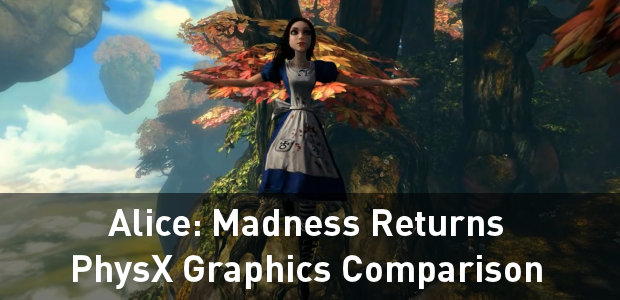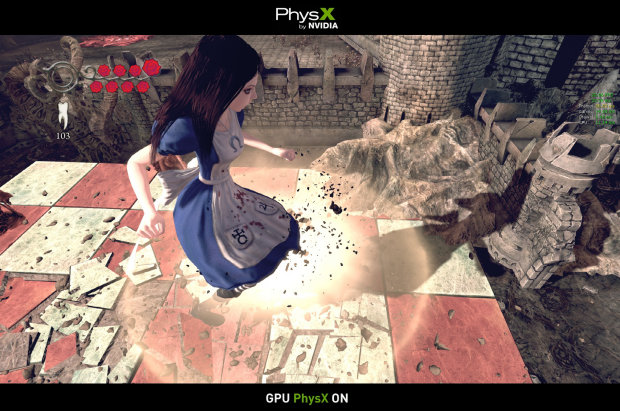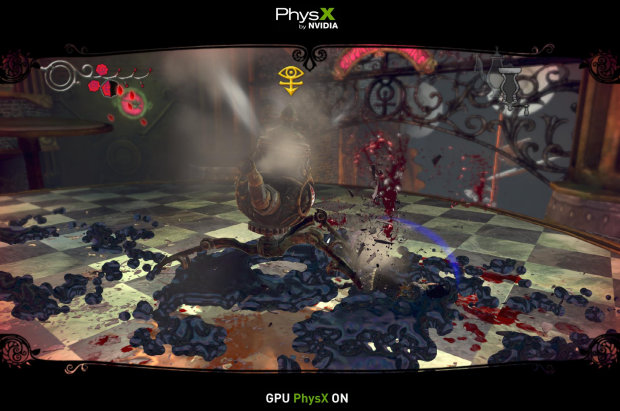Alice: Madness Returns: PhysX Graphics Comparison - Page One
Note that this is an archived copy of the original article. Please see here for a more detailed explanation.
June 14, 2011
By Andrew Burnes

Alice: Madness Returns is arriving on shop shelves the world over this week, and those who purchase the multi-platform title will undoubtedly enjoy its pleasures, especially if they played the year-2000 original, American McGee’s Alice. A continuation of the same story, Madness Returns sees Alice plunge back down the rabbit hole into a world of insanity, which just happens to create some of the most inventive and imaginative vistas and scenarios of any game in recent years.
On the PC, however, those with compatible NVIDIA graphics cards will be able to experience Madness Returns with an extra level of immersion thanks to the implementation of hardware accelerated PhysX effects. Not only will they receive a better visual experience than players on consoles due to higher resolution textures and advanced anti-aliasing, they’ll also experience the game in a way others won’t, as this article will illustrate.
The PhysX effects in Alice are the outcome of a two-way collaboration between the developer, Spicy Horse, and NVIDIA’s Developer Technology Team. Having helped the developers of Batman: Arkham Asylum, Cryostasis: Sleep of Reason and Mirror’s Edge enhance their games with PhysX, Alice: Madness Returns, with its unique style and fantasy setting, was the perfect title to augment with PhysX technology. The process began with the developers approaching NVIDIA, and from there, NVIDIA’s team demonstrated past PhysX implementations in other titles and shared information the best way to utilize PhysX effects in the game. In turn, Spicy Horse suggested how they would like to enhance their title, and NVIDIA’s PhysX artists created examples for Spicy Horse to refer to. “This typically involves marking up screenshots and developing prototypes to get a good feeling of how these effects will help enhance the game,” explains NVIDIA PhysX artist Dane Johnston.
By using all the effects and technologies available to them, developers are able to enhance their existing game designs without increasing their workload by a significant degree. “Destruction is a good example of this,” explains NVIDIA’s David Schoemehl. “Take the chessboard in Madness Returns. Using a destruction effect and tool we were able to make the existing asset deform in such a way that it will shatter when Alice hits it with her Hobby Horse weapon or stomps on it.” This enhancement creates an extra level of immersion as Alice now appears to wield real strength when swinging her heavy melee weapon, and the world of Wonderland responds to this, giving the player a sense of power and feedback in the fantastical environments that they would otherwise lack.

An oversized Alice exacts her revenge on a dastardly chess board, its tiles cracking and deforming realistically according to the forces exerted upon them. Furthermore, note the extra particle effects emanating from the focal point of the impact.
For Madness Returns Spicy Horse investigated the addition of realistic fluid rendering to enhance the game world and all elements contained within. Unfortunately, the Spicy Horse developers were unable to attain an acceptable in-game framerate with their software-based solution, so NVIDIA looked to PhysX-powered fluid simulation technology as a possible addition to the game. Due to the technique’s complexity and computational requirements, consoles and PC CPUs were insufficient for the task, which is where PhysX acceleration entered the picture. By offloading the required calculations to the GPU, the CPU isn’t burdened and the game’s frame rate doesn’t suffer. In-game, the fluid is rendered as a thick, oily goop that is typically spread by enemies after suffering the wrath of Alice.
Having already simulated fluids in Action Forms’ Cryostasis: Sleep of Reason, NVIDIA’s team had experience with the required technique, succinctly known as Smoothed Particle Hydrodynamics. Rendering fluid as a set of moving particles, rather than a solid, pre-canned animation as in other games, Smoothed Particle Hydrodynamics allows fluid to collide accurately with the static environment and move realistically when a solid object or character interacts with it. With NVIDIA’s implementation of Smoothed Particle Hydrodynamics, the density of the goop is constantly measured against the number of neighboring particles within a certain radius, and so when an object interacts with the goop the density smoothly varies and transitions as the particles move around. And as the object exerts forces upon the fluid the shifted particles become temporarily larger than the main body of liquid, resulting in a puddle or splash depending on the aforementioned forces, and in a complex scene there can be over 10,000 simultaneous particles being rendered in total. Comparatively, as shown in the example above, a non-PhysX accelerated scenario features no goop whatsoever, and so, when the enemy attacks, there is less of a physical ‘feel’ to the impact of their projectile. Similarly, by emitting goop when attacked by Alice the enemies now provide feedback, showing that her attacks are damaging and are having an effect.

This side-by-side comparison says it all. Note how the enemy’s projectile forces the goop to splash upon impact and how the goop is dispersed due to Alice’s movement.
Explaining the difference between Alice’s goop and that of fluids in other games, such as Portal 2’s gels, which impressed many a player and were achieved even on consoles, NVIDIA’s David Schoemehl explains that, “the most noticeable difference with the fluid in Alice is that it does not become a decal when it hits the ground; it is constantly interacting with the ground, objects and player in order to provide the user with a truly immersive effect.”

Fully calculated, realistic physics in action: note how the goop has fallen to the ground after hitting the Eyepot, leaving the area directly underneath it clear and clean.
Continue to page two to read about PhysX Particle usage in Alice: Madness Returns >>
 Previous
Previous
Comments
This comment section is currently disabled. Click here to enable comments and load all Disqus related resources
Please note that by enabling and loading these Disqus resources, you are agreeing to allow everything that comes with a Disqus comment section, including their cookies and all scripting.
This comment section is currently enabled. Click here to disable comments and unload all Disqus related resources
Please note that I have absolutely zero control over this comment section. It is still administered entirely by Nvidia themselves. I have no moderation power whatsoever and don't necessarily endorse any of the comments posted here. In fact, I don't believe this comment section adds much value to the article to begin with but included it only because it existed on the original.